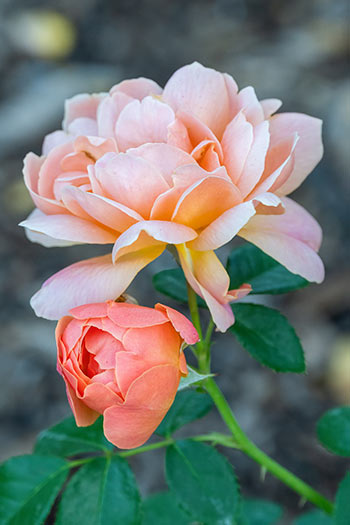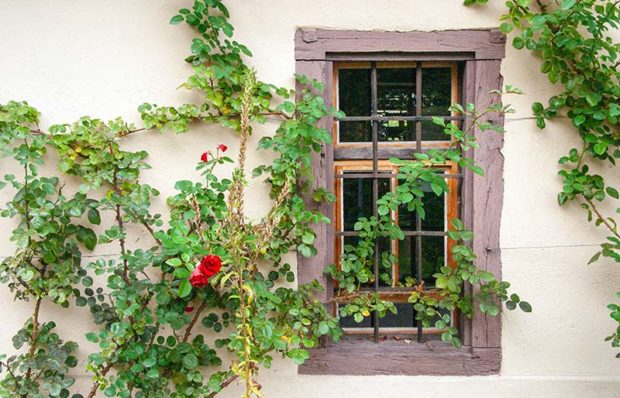Roses are just like people—they need just five things to thrive:
- Sun
- Air
- Food
- Water
- Love
Mother Nature can handle the first two needs (sun and air) by herself. But she needs your help with the second two (water and food) in order for your roses to survive. You are the sole provider of the last need (love). And it’s that one that spells the difference between roses that simply survive, and those that thrive.
Let’s consider each of these needs:
Sun. Roses are sun-loving plants. Typically roses need at least six hours of full, direct sunlight daily and will do better if they receive more.
For areas that receive between 4 and 6 hours of direct sun, select five-petaled roses. These are roses with a lower petal count and, in general, the lower the petal count, the more shade a rose will tolerate. As a group, hybrid musk and antique alba roses are fairly shade tolerant—mainly because they have simple blooms.

Air. Roses like good air circulation to keep their leaves dry and to prevent fungal diseases. However, avoid exposure to strong winds. Consider the most rugged roses, like rugosas and Canadian explorers, for your cottage on the Great Lakes. Otherwise, plant your roses where they will enjoy gentle breezes. Remember this if you plant near a wall or solid fence.
Remember, roses grow quickly, which means you should thoughtfully consider the spacing between bushes. Follow this rule of thumb: roses generally grow to be as wide as they are tall. So, roses expected to be four feet tall should be planted about four feet apart, as measured from the center of one bush to the center of the next.
Hybrid tea roses can be planted closer together, while antique and shrub roses should be placed a little further apart. Remember, too, that climbing roses need lots of room. Plant them at least 6 to 8 feet from neighboring climbers.
It’s a common misconception that roses shouldn’t be planted near other types of plants. In truth, they can be part of an integrated landscape provided neighboring plants don’t crowd them and prevent good air circulation.
Food. Roses are heavy feeders and appreciate richly amended soil. They are adaptable to soil type. They’ll thrive in sandy soil if you feed them frequently, and in clay soil if they have good drainage. The solution to sandy-soil and clay-soil problems is the same: organic amendments. Many municipalities produce wonderful compost from the grass clippings collected from homeowners. Usually this compost is free for the hauling.
Apply your first fertilizer in late April or early May. Slow-release fertilizers need only be used once or twice a year. Organic options should be used every 4 to 6 weeks. In any event, your last fertilizer application should be in mid-August, so that your roses ease into dormancy before the first heavy frosts.
The commonly available rose fertilizers with systemic insecticides should be avoided because they will kill earthworms. Treat insect problems as they occur—you don’t need to “nuke” your entire garden to eliminate a few aphids or budworms when targeted attacks will be sufficient. Also, foliar-feed fertilizers give your roses a nice snack, but they are too quick-acting and transient to be used exclusively.
Water. Roses like lots of water, but not wet feet. In other words, be sure the plants are in a well-drained soil. We simply do not receive enough natural rainfall in Michigan for roses to thrive, which begs the question, how much is enough? Some will tell you 1 or 2 inches per week. However, it really depends upon your soil type and drainage. The goal is to keep the soil near the rose roots evenly moist. This means you’ll need more water in sandy soil than in clay. Try installing a rain gauge near your roses so you can see exactly how much water they are receiving.
The belief that you shouldn’t permit rose leaves to get wet is a myth. In our nursery, we watered our roses exclusively with overhead watering. We found that it helped wash off powdery mildew and insects. It helped that we watered early in the morning so that the leaves dried as the day came on. This prevented fungal diseases that can form when leaves are wet for an extended period or overnight.
Most residential in-ground irrigation systems are optimized for turf grass and do not provide enough water for roses. You can supplement these systems by hiding a soaker hose under the mulch around your roses. Your irrigation contractor may recommend a special drip irrigation circuit for roses, but be prepared to check the emitters frequently—clogging is a common problem.
A good organic mulch, such as finely ground pine bark, pine needles or garden compost will help the soil retain moisture and reduce the need for frequent watering.
Love. Spend a little time with your roses, deadheading spent blooms and checking the moisture content of the soil at their roots. That way, while you are enjoying their beauty, you’re likely to notice “conditions” before they become “problems.”
Roses can be the stars of your garden, so plant where you can admire them frequently—their blooms are abundant and fabulous. Follow the guidelines presented here, and you’ll be amazed at their display!
Nancy Lindley was the co-owner of Great Lakes Roses in Belleville, MI.
Related: Simple steps to keep roses healthy for the summer
Elsewhere: Downy mildew control on roses


